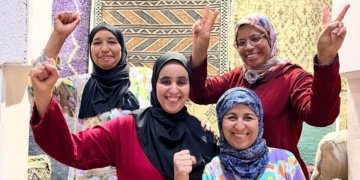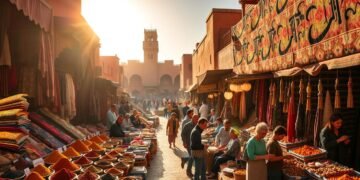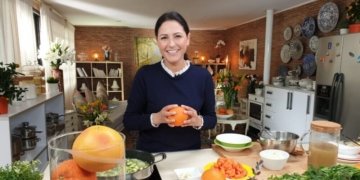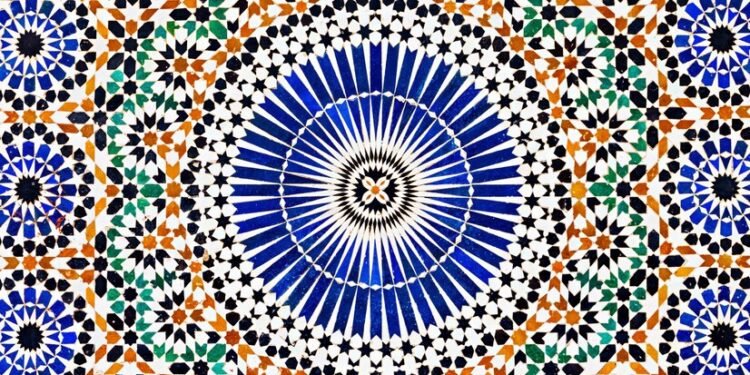Immerse yourself in the vibrant Moroccan art scene, a world rich in craftsmanship and history. This colorful realm, filled with the intricate patterns of Zellige tilework, plush textiles, and harmonious traditional music rhythms, evokes the country’s cultural richness. This comprehensive guide takes you through the versatility and charm of Moroccan art.
Unveiling the Mystique of Moroccan Art
Moroccan art exudes a charm capable of bewitching art connoisseurs globally. Each artwork, whether it is the delicate tilework or plush textiles, captivates with a unique fusion of various cultural influences. The audacious use of colors and geometric patterns, crafted with finesse, underscore the nation’s rich artistic lineage. For instance, the traditional Moroccan zellige tiles breathe life into intricate mosaic patterns and make for a visual treat.
Moroccan textiles, from the iconic Berber rugs, underscore the artisans’ innovative skills. The beauty of these creations is reflective of Morocco’s cultural persona and serves as a global design inspiration.
Exploring the Rich History and Cultural Significance
Delving into Moroccan art’s humbling history and cultural relevancy unravels a universe filled with vibrant expression and detailed craftsmanship. The varied influences – Arabic, Berber, and Andalusian – find vivid representation in the country’s art, from the Zellige tilework’s geometric motifs to the silver jewelry’s delicate filigree designs. The bold colors and meticulous patterns signify the nation’s rich trade and exploration history, along with indigenous customs.
For instance, traditional Moroccan carpets beautifully blend Arab and Berber motifs. The culturally significant henna tattooing art form finds resonance during special events like weddings. The myriad art forms offer engrossing insights into the country’s past, showcasing an abundant heritage and a flair for artistry.
The Influence of Islamic Art on Moroccan Traditions
The impact of Islamic art on Moroccan traditions is evident in various art forms, including architecture, pottery, and calligraphy. The intricate beliefs and floral themes prevalent in Islamic art are beautifully illustrated in Moroccan architecture’s detailed tilework and plasterwork. The bright colors and delicate patterns seen in Moroccan pottery underscore Islamic art’s influences.
The artistry of calligraphy, a core element of Islamic art, finds a place in Moroccan art through decorative items like wall hangings and textiles.
Traditional Techniques and Craftsmanship
An integral part of Moroccan art includes traditional techniques handed down over generations. These commemorative methods help to preserve Moroccan cultural heritage. Artisans continue to create intricate designs using time-honored methods, employing techniques like Zellige tilework, hand-woven fabrics, and wood carving. The creation of Zellige tilework, for example, involves individual tile shaping and glazing, assembled thereafter into dazzling geometric patterns.
Showing competent artistry, Moroccan weavers produce vibrant textiles, employing traditional looms for their production. This dedication to preserving artistry ensures the continuation of an authentic artistic tradition.
Distinctive Features of Moroccan Art
A Kaleidoscope of Colors: Vibrant Palette in Moroccan Art
The Moroccan artwork, known especially for its diverse and bright color palette, mesmerizes with a fascinating array of shades. From earthy terracotta hues to the vibrant blues inspired by the Mediterranean Sea, the color spectrum adds life to the artwork. The country’s cultural traditionalism and heritage are beautifully mirrored through the bold and intricate shades. A testament to this vibrancy is evident in Moroccan architecture, textiles, and pottery.
Geometry and Symmetry: An Integral Element of Moroccan Art
Geometry and symmetry play vital roles in Moroccan art, contributing significantly to its distinctive style. The artwork, dominated by intricate geometric patterns, also finds relevance in ceramic ware and textiles. Symmetrical motifs, creating balance and synchronization, are often integrated into these patterns. For instance, the zellige tilework, characterized by its geometric symmetry, showcases the precision of Moroccan artisans.
A similar use of symmetrical motifs characterizes Moroccan carpets and textiles, which highlight the detailed workmanship by showing the importance of balance in the artwork.
Intricate Woodwork: Masterful Carvings in Moroccan Art
Moroccan art features intricate woodwork known for the elaborate designs that skilled artisans carve into various wooden items. Whether it’s furniture, doors, or decorative pieces, the astounding workmanship, exemplified by its attention to detail and the integration of geometric motifs, traditional symbols, and arabesque aesthetics, is testimony to the country’s rich heritage. Moroccan woodwork’s mind-blowing intricacy adds a unique charm to the craft.
Zellij: The Traditional Moroccan Mosaic Art
Zellij, a traditional Moroccan mosaic art form, features a detailed arrangement of countless colorful tiles, creating hypnotic geometric patterns. Revealing exquisite craftsmanship and detail, this ancient art form adorns various settings, such as palaces, public spaces, and mosques. This showcases its cultural importance and significance in Moroccan culture.
Beyond aesthetics, Zellij represents the unbroken chain of generations of artists who dedicated their lives to the preservation of this art form.
Exploring Different Forms of Moroccan Art
Moroccan Ceramics: Tales in Clay
Known for their elaborate designs and cultural nuances, Moroccan ceramics are more than decorative items. Each piece, meticulously crafted by hand, tells a tale of the country’s history and traditions. The detailing and finesse in the pottery, livid with vibrant geometric patterns and delicate floral motifs, demonstrate Moroccan artisans’ astounding skills. The ceramic works are great representations of the country’s artistic traditions and are valuable collector’s items.
Whether displayed with pride or used in daily life, Moroccan ceramics enhance any space with their elegance.
Exquisite Textiles: A Fusion of Luxury and Craftsmanship
Moroccan textiles stand for a seamless amalgamation of luxury and skill. Every aspect of the creation process – from the intricate techniques to the meticulous detailing – results in high-end products. Take, for instance, the hand-woven rugs or the intricately embroidered fabrics; each tells a tale of marvelous artistry. The use of looms, handed down through generations, preserves the Moroccan cultural legacy.
The choice of premium raw materials such as silk and wool lends an additional layer of sophistication to the textiles. The care and skill manifested in every textile piece showcase the fusion of luxury and skill found in Moroccan art.
Calligraphy: An Expression of Spiritual Beauty
A unique form of visual art, Moroccan calligraphy, articulates a profound spiritual connection. The flowing lines and intricate designs convey deep meanings, embodying sentiments of love, peace, and devotion. Moroccan calligraphers, through their craftsmanship, express their spirituality while inspiring contemplation and reflection. This traditional art form has flourished globally, a testament to the invincible beauty of Moroccan culture.
Metalwork and Jewelry: Adorning Moroccan Arts
The role of metalwork and jewelry in Moroccan art is noteworthy. Moroccan artisans are renowned for their skills in intricate metalwork and jewelry design, celebrated worldwide. The artistic portrayal is evident in the delicate filigree work, ornate engravings, and vibrant gemstone embellishments. Metalworkers use age-old techniques to create eye-catching pieces such as lanterns, tea trays, and decorative boxes.
Jewelry crafters employ precious metals like gold and silver to create elegant pieces. These artistic creations not only reflect Moroccan culture and heritage but also serve as timeless adornments.
Experiencing Moroccan Art in the Modern World
Contemporary Moroccan Artists: Reinterpreting Tradition
Modern Moroccan artists draw inspiration from their cultural artistic heritage while incorporating contemporary approaches. They reinvigorate Moroccan art, making it contemporary, by incorporating traditional techniques and mediums.
For example, some have merged traditional Moroccan calligraphy with abstract forms, creating a fusion of the old and the new. Others employ unconventional materials like recycled objects to highlight environmental challenges. Their innovative approaches preserve Moroccan artistic traditions and contribute to the contemporary global art scene.
Artisan Cooperatives: Empowering Moroccan Artisans
Artisan cooperatives play a significant role in empowering Moroccan artisans. By creating a collaborative platform, they support artisans in preserving and promoting traditional crafts. Cooperatives promote collective work, reaching broader markets, and securing equitable economic rewards. In these cooperatives, artisans can pool resources to invest in modern tools and technologies, enhancing production and efficiency.
Additionally, cooperatives often organize workshops and training sessions that strengthen artisans’ skills, helping them adapt to evolving consumer preferences. These initiatives play a vital role in supporting Morocco’s rich artistic heritage.
Moroccan Art Festivals and Exhibitions: Showcasing Creative Excellence
Festivals and exhibitions dedicated to Moroccan Art highlight the country’s incredible creative talent. These events provide artists with a platform to exhibit their work, garner recognition, and interact with a wider audience.
For example, the Marrakech Biennale, which attracts artists worldwide, facilitates cross-cultural exchanges and engenders inspiration. Events like the Fes Festival of World Sacred Music celebrate the diversity and richness of Moroccan art forms, enabling artists to establish a broader connection with audiences and contribute towards a more vibrant Moroccan art scene.


























